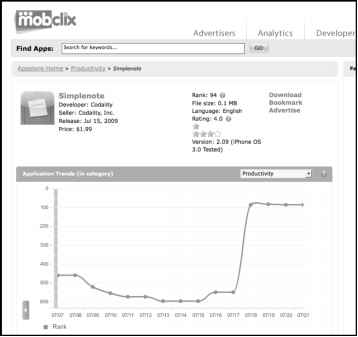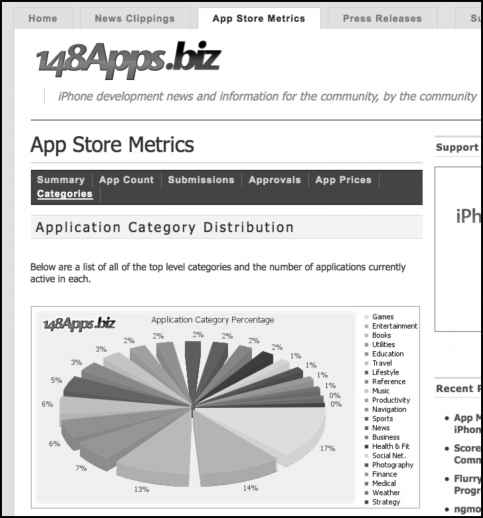Analyzing App Ranking Statistics
After getting a handle on how much competition is out there for your particular niche, it's also important to find out how your competitors are faring in the App Store. Are they ranked high in the App Store charts? Have any of them broken out of their primary categories to rank well in overall downloads? Do those apps perform better in some countries but not in others? This information can also help you determine whether a particular niche is popular or profitable enough to warrant your own development investment in it. Your iTunes Connect account limits you to only your own app statistics, but thankfully, some amazing alternatives can assist in your competitive research quest.
Mobclix
http://www.mobclix.com/appstore/
Beyond offering a compelling platform of iPhone services, ranging from embedded mobile advertising to sophisticated app analytics, Mobclix also provides comprehensive app rankings for the U.S. App Store (see Figure 2-5). Want to investigate the charting trends of your competition or even your own apps? You can find a wealth of valuable information here. The Mobclix web site should be a required destination for all iPhone developers.

- Figure 2-5. Charting the app ranking history of Simplenote at Mobclix.com
MajicRank
http://majicjungle.com/majicrank.html
Majic Jungle Software's David Frampton has created a very handy free Mac OS X application that allows you to easily track iPhone app ranking statistics across "The Big Eight" countries, as well as many other countries (see Figure 2-6). David has put a lot of work into this free software tool, so if you find it useful, consider buying one of his iPhone apps as your way of saying thanks.

- Figure 2-6. Tracking app rankings with the free Mac OS X app, MajicRank
APPlyzer
APPlyzer is a popular web-based source for free and paid app ranking statistics (see Figure 2-7). It's a subscriber-based service for tracking paid apps, but it offers the service free for tracking free apps. This site really provides an extensive amount of information for both regional App Stores and overall worldwide stats, so it's well worth the small fee to upgrade to the premium service.

- Choose your subscribed App Bump t I Show Rankings
|
Country |
Social Networking |
Top Overall |
|
United States |
6 [7] £ |
123 [117] ^ |
|
Canada |
7 m £ |
217 [208] fy |
|
Japan |
7 [7] ^ |
223 [219] ^ |
|
Macau |
8 [8] ^ |
293 [235] (fj |
|
Thailand |
8 [8] ^ |
236 [238] ^ |
|
Greece |
9 [10] £ |
327 [330] ^ |
|
Romania |
9 [9] ^ |
364 [316] (f^ |
|
Australia |
11 [10) |
270 [253] (f^ |
Figure 2-7. Comparing the rank of Bump in different countries at Applyzer.com
http://148apps.biz/app-store-metrics/
App Store Metrics by 148Apps.biz
http://148apps.biz/app-store-metrics/
This is a great web site, chock-full of iPhone development news and business insights. But beyond all of its wonderful content, 148Apps.biz may be best known for its comprehensive App Store metrics, which include statistics on active app count, submissions, approvals, app prices, and distribution of apps across the various categories (see Figure 2-8).

- Figure 2-8. 148Apps.biz reveals the number of iPhone apps in each category.
Top App Charts
Top App Charts offers a unique spin on app ranking statistics by charting the big movers and shakers on the lists. Similar to APPlyzer, this free site uses visual markers for big debuts, jumps, and drops to reveal the actual movement of apps through the ranks.
Yappler's App Store Stats
http://www.yappler.com/Apple-iPhone-App-Store-Stats/
Even though Yappler was already listed earlier in this chapter as an app directory site, it also provides some interesting App Store statistics worth checking out.
Other Resources for App Ranking Statistics
Although several other app analytics services, web sites, software tools, and even a few cool iPhone apps track App Store ranking—such as AppFigures, AppViz, and Heartbeat—they're more focused on analyzing your own app's statistics and collecting data from your iTunes Connect account's sales logs. So, even though these resources may fall beyond the scope of competitive research, don't worry—they'll be profiled here in later chapters.
Continue reading here: Defining Your Differentiator
Was this article helpful?